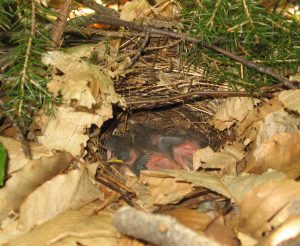
Ovenbird nest with chicks
By Fredlyfish4 – Own work, CC BY-SA 4.0, Link
The density of ovenbird territories declines as intensity of forest harvesting increases (BBMP2)
View:
– Questions about forestry science forwarded to NSDNR
Post on HFN website Apr 25, 2017
– Impacts of forestry in Nova Scotia on conservation of biodiversity: Concerns and Questions
HFN Conservation Committee document (PDF), Apr 26, 2017
From the summary:
The HFN Conservation Committee has reviewed various documents that NSNDR cites as providing a scientific basis for its forestry policies and practices, some produced in-house, some not. In this document we express our understanding of and raise specific questions related to the nature and extent of clearcutting/even-aged management in Nova Scotia, the policies, the science underlying those policies and some of the impacts on biodiversity.
To the extent that we understand the scientific literature and NSDNR policies and practices, we have concluded that:
– In relation to LANDSCAPE LEVEL IMPACTS OF FORESTRY PRACTICES ON BIODIVERSITY there are serious deficiencies or flaws in some of NSDNR science that is being applied; the resulting extensive clearcutting is having serious negative impacts on biodiversity and ecosystem services.
– In relation to MITIGATING AND ADAPTING TO CLIMATE CHANGE, scientific evidence and procedures developed outside of NSDNR that should be applied to forestry in Nova Scotia are apparently not being applied (or the public has not been informed about NSDNR’s application of this science). In this context, Nova Scotia is not meeting its commitments under EGSPA and is doing far less than it could to adapt to and mitigate climate change.
– In relation to SOIL ACIDIFICATION & LOSSES OF CALCIUM, a suite of research by aquatic scientists that should have raised alarm bells about sustainability of forests and forestry and associated aquatic systems a decade and more ago has not been heeded (highlighted) by NSDNR, and now NSDNR is being very reticent about applying and publicizing its own, rigorously conducted science in this area. We are particularly concerned about the impacts of not taking a more precautionary approach to harvesting in SW Nova Scotia, the area most strongly affected by acid rain and nutrient-poor soils. These conditions are known to be seriously affecting aquatic systems and, based on research elsewhere, are very likely having major impacts on forest health and biodiversity.
